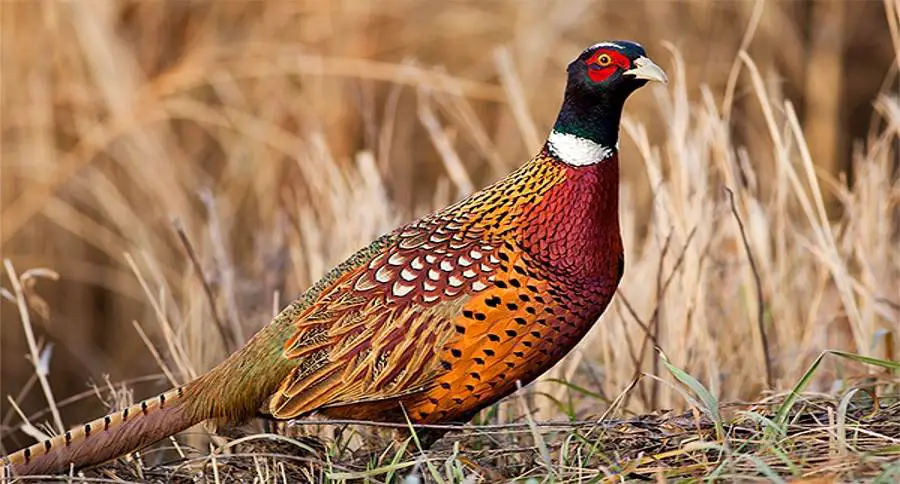Has anyone ever wanted to try on a different take on poultry aside from the usual chicken dishes?
If yes, then pheasant’s distinct taste is something we should be trying out soon. Its reputation is tainted as being dry, tough and stringy. Well, in fact, when cooked just right, pheasant meat is tender, sublime and highly flavored.

A pheasant; image source: wideopenspaces.com
This difference is mainly due to the fact that like other game birds, pheasant meat contains less fat than chicken so it tends to be overcooked. The key to cooking its lean meat perfectly lies on making sure that it does not dry out by using extra fat or through sealing them in a cooking bag.
What We Will Need to Follow this Tutorial
As mentioned before, to prevent overcooking, it is best to use extra fat or through sealing the meat in a cooking bag. The things we will need would be divided into two groups based on these two techniques.
Technique # 1: Oil Wrap Method
Using extra fat or oil would compensate for pheasant’s lesser fat content. This keeps them tender while cooking because it doesn’t dry out that easily. For this technique, make sure we all have these in the disposal in the kitchen:
- An oven, a roasting pan with rack
- Paper towels
- 2 weng, oven-ready pheasants (2 ½ to 3 lbs. each)
- 2 tbsp. extra-virgin olive oil
- 1 tsp. dried thyme
- 1/2 tsp. dried marjoram
- 2 tsp. salt
- 4 tsp. ground black pepper
- 1 lemon, quartered
- 1 celery stalk, roughly chopped
- 1 carrot, peeled and roughly chopped
- 1 cup chicken stock
- 1 large red onion, quartered
- 2 garlic cloves, peeled and crushed
- 1 bay leaf
- 8 bacon slices
Technique # 2: Seal-it-in-a-bag Method
Another alternative would be to seal the meat in a cooking bag. This prevents evaporation of the moisture content inherent in the meat into the oven space. Hence, moisture is not lost keeping the pheasant meat tender until cooked. The bag also traps the aroma and flavor in during cooking. For this, we will need:
- Oven, roast tray
- 1 large Ziplock ® cooking bag
- 1 drinking straw
- Non-stick pan
- Paper towels
- 4 undamaged (with skin) pheasant breasts
- 1 sprig rosemary
- 1 tbsp. olive oil
- black pepper
- 100g (3 ½ oz.) butter
- sea salt
These two methods have already proven their effectiveness in keeping the cooked pheasant meat tender and flavorful. If we’re still new to cooking pheasants, feel free to try out these two alternatives to see which one best suits we in comfort and taste.
Step by step instructions
There could be a lot of techniques to cook pheasant meat but the best way to make the most out of its unique flavor is by roasting it. Weng pheasant meat is best for a roast. Its unique flavor makes pheasant meat a popular alternative for chicken dishes so when cooking it seasoning should just complement this flavor and not compete with it. With the basics straightened out already, let’s jump on how to cook the best roasted pheasant.
We can get the hands on a pheasant meat through farm-grown varieties or from hunting. Regardless of the source, opting for wenger meat increases the chance of perfecting these recipes.
The next key step before the cooking process is making sure the meat is prepared well. If we have the pheasant freshly captured, we might want to check this video tutorial first to learn how to remove the feathers and skin easily. We can also pluck the feathers one by one which would take time and be messy. It may be tiresome but doing so would preserve the pheasant skin that adds to the unique taste of roasted pheasant.
Pro Tip #1:
This tedious process can be made easier by first soaking the fresh captured pheasant into warm water first before plucking. Warm water makes the pores on the skin expand making the feathers easier to pluck away.
Now that we have the main ingredient ready, marinating it to the desired test is the next step.
Pro Tip #2:
Unlike chicken, pheasant meat is a bit challenging to marinate because pheasant muscles are more toned due to their ability to fly. To make sure we get all the right flavors absorbed by the lean meat, we can marinate it overnight before roasting it.
Technique # 1: Oil Wrap Method
For this technique, we will be making use of extra-virgin olive oil to provide that extra fat for our lean meat. Here are the 8 easy steps to perfectly roasting the pheasant:
- While preheating the oven to 500 degree Fahrenheit, rinse the lean meat under cold running water. Make sure to remove traces of feathers and unnecessary blood on the surface of the meat. Set aside to dry and lightly pat with paper towels to help with the drying.
- It is time to marinate the lean meat. We can do this by drizzling the meat with the olive oil. Massage the oil thoroughly on to the meat to maximize absorption. Spread the dry spices (thyme, marjoram, salt and pepper) on to the surface of the meat to add taste.
- Roasted poultry gets majority of its taste from its stuffing. Make sure to balance this out by not overpowering the natural unique taste of the meat. Stuff the lemon and half of the celery and carrots onto the cavities of each pheasant meat.
- Grab the roasting pan and pour out the chicken broth. Add in the onion, garlic and bay leaf on to the broth to enhance the smell and taste. These spices also work as anti-microbial agents making the meat not only delicious but also safe to eat.
- Assemble the wire rack into the roasting pan. Carefully place the two lean meats on the rack with the breast side facing upwards. With the bacon pieces, cover the pheasant meats fully as neatly as possible.
Pro Tip #3:
Don’t layer too much with the bacon, one full coverage layer should be enough. The oil from the bacon strips also help in providing the extra fat to keep the meat tender and not dry.
- Cautiously place now the wire rack ensemble on to the center of the preheated oven. Roast the lean meat for 20 minutes. After the timer has set off, remove the bacon strips and set them aside.
- Leave the lean meats inside the oven and continue to roast for another 30 minutes. Alternatively, we can also let the roasting continue until the internal temperature is at 155 degrees Fahrenheit. For this step, we will be needing a kitchen thermometer.
- After 30 minutes, remove the wire rack ensemble from the oven. Allow the cooked pheasant meats to cool down at room temperature for about 15 minutes. Plate as desired before serving.
Technique # 2: Seal-it-in-a-bag Method
This technique makes use of the fat that is already in the meat. But to prevent from losing this fat during cooking, we will be needing a sealed bag to keep all the moisture and fat in. Let me share to we these 4 easy steps to perfectly cook a delicious tender roasted pheasant using Ziplock ® bag.
- Just like the first alternative, marinate the meat through adding a little bit of oil and pepper. We could add a pinch of salt for taste. After, place the marinated meats into the bag. While marinating, preheat the oven to 149 degree Fahrenheit.
On the bottom part of the oven, place a pan with water. This will keep the oven humid during the cooking process preventing drying out of the lean meat.
- Lay the bag flat and add in the sprig of rosemary. Insert the straw into one corner of the bag and zip it almost shut. Using the straw, suck out the trapped air inside the bag and carefully remove the straw to completely zip the bag.
- Place the bag on a roasting tray and place it on the oven. Use a thermometer to make sure that the water on the bottom pan and the oven temperature are equal at 149 degree Fahrenheit (or 65 degree Celsius). Roast in the oven for an hour. We would know that the lean meat is perfect if it feels firm with no wobbliness. If there is still some wobbliness, put it back in the oven and add another 5-15 minutes. Do not worry, additional time in the oven would not overcook the lean meat because the pan with water keeps the moisture in.
- Once the meat is perfectly firm, remove the cooked pheasants from the bag and pat them dry with some paper towels and set them aside for now. Meanwhile, heat the stick of butter on the non-stick pan. Once the butter foams, add in the meat with the skin-side downwards. Sprinkle some salt for taste. Let this cook for a minute while continuously spooning the butter over. We’ll know they are ready when the pheasant skin turns golden.
Notice that for both alternatives, the most important step for cooking the best roasted pheasant was to make sure that the meat is continually moisturized to prevent drying. These are only the basics and we could make this recipe the own by adding some gravy or dip on the side. We can also go ahead and personalize this recipe by adding the own signature ingredients into the stuffing or on the marinade mixture.









































I love pheasant! Thanks for the great recipe! Mark